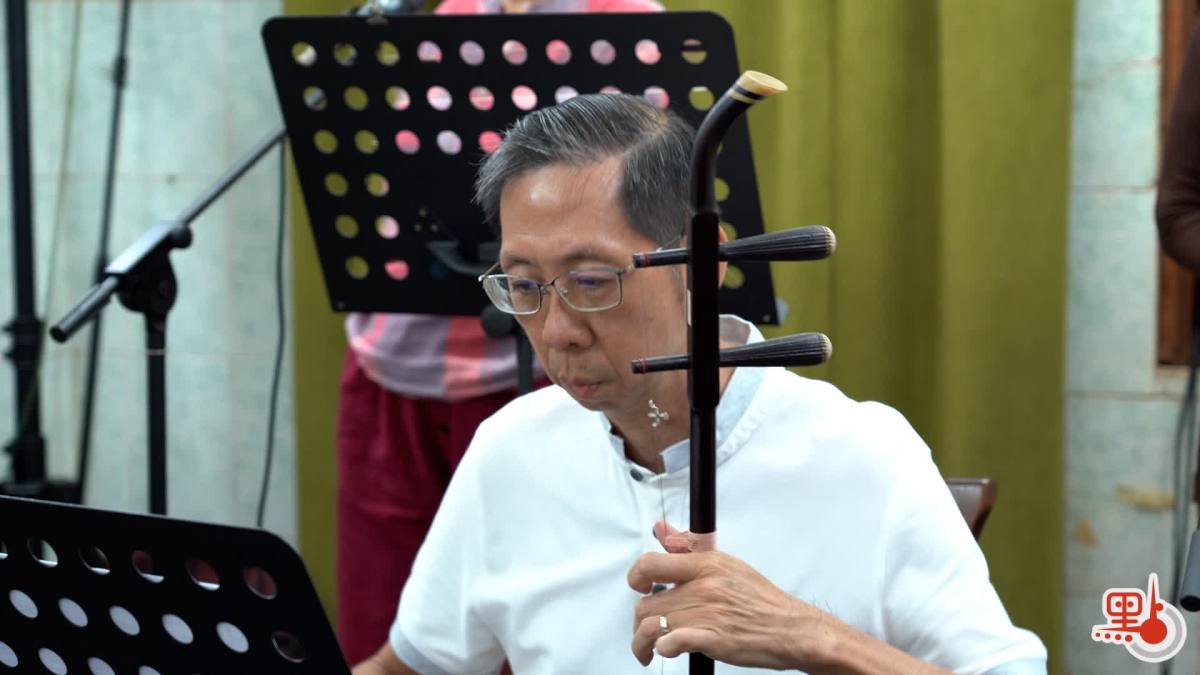Around 8 p.m., in a tucked-away corner of Jalan Pudu, Kuala Lumpur, musicians are slowly taking their places for the final rehearsal of the upcoming Hainan Bayin performance.
Mak Ying, of Hainan descent and a Qiong Opera drum master, is the lead coordinator of this performance. For many years, she has dedicated herself to reviving and promoting Qiong Opera and other Hainanese music in Malaysia and abroad. She emphasizes that what matters most to her is incorporating the nearly forgotten Hainanese dialect and catchphrases of elders into her works, using these works to preserve their words and stories.

Hainan Bayin is a vital piece in Mak's effort to revive traditional Hainanese music, most of whose tunes overlap with those used in traditional Qiong Opera. Hainan Bayin takes its name from the eight categories of instruments used in its performance—bowed strings (xian), plucked or struck strings (qin), flutes (di), reed pipes (guan), vertical flutes (xiao), gongs (luo), drums (gu), and cymbals (nao). In Malaysia, Hainan Bayin was traditionally performed at temple festivals and ancestral worship ceremonies. However, as most of the musicians who originally performed Hainan Bayin have grown older and are unable to continue performing, there are no longer any active Hainan Bayin troupes in Malaysia. As a result, Hainan Bayin performances have disappeared from Malaysia for over a decade.

Under these circumstances, Mak initially found it "quite challenging" to revive Hainan Bayin performances. "But later I changed my approach," she said. "I thought about inviting some musicians from a Chinese opera orchestra. We could make a Hainan Bayin performance possible through collaboration."
Yeung Wai-hung, the gaohu player, was one of the musicians Mak "borrowed" from the Cantonese Opera troupe. His earliest experience with Cantonese Opera was listening to vinyl records with his grandfather. As he grew older, his grandmother and mother also took him to opera tents to watch Cantonese Opera and ritual operas, making him a true opera enthusiast who genuinely "grew up under the opera tents." Motivated by this passion, Yeung eventually began learning the erhu and gaohu. In recent years, as the number of musicians has steadily declined, Yeung, who started learning Cantonese Opera later in life, was brought in to help and now serves as a part-time Cantonese Opera musician.

"The Entire Field Is Shrinking Rapidly"
"The entire field is shrinking rapidly," said Yeung. He pointed out that in Malaysia, not only Hainan Bayin, but even the once-thriving Cantonese Opera is now struggling to survive.
Yeung explained that the average age of traditional opera musicians in Kuala Lumpur is now around 75. During the pandemic, many either left the profession or passed away, leaving only one and a half Cantonese Opera troupes. With the available musicians, if a full ritual opera is staged, the remaining performers could only manage zhezixi (highlights from operas).
But Yeung remembers that Cantonese Opera once thrived in Malaysia. He recalled that from the 1950s to the 1970s, there were as many as 32 registered Cantonese Opera troupes locally. Besides performances by local troupes, Hong Kong masters such as Franco Yuen Siu-fai and Law Kar-ying also frequently performed in Malaysia.
However, things began to change in the 1980s. As theaters flourished, audience preferences shifted along with them. At the same time, rapid urban development made it harder to set up opera tents in the city. As a result, Cantonese Opera troupes in Malaysia had to relocate to remote areas, and Cantonese Opera gradually declined.
According to Yeung, even in Perak, where Cantonese Opera is still practiced more than elsewhere in the country and is home to one of the largest Cantonese communities in Malaysia, the number of days ritual opera is performed each year has declined steadily, from 30 days to just 15 days in 2023.

Decline Rooted in the Cantonese Opera Community
Why is traditional Chinese opera in decline? Whether it's Hainan Bayin or Cantonese Opera, the reason seems to be the same—the performers and audiences are mostly elderly, with very few young people willing to learn or get involved.
Language is a major barrier. As Mak points out, Hainan Bayin and Qiong Opera are performed in the Hainanese dialect, a language most young people today neither speak nor understand. That makes it hard, even frustrating, for them to enjoy or take part in these performances. While Cantonese Opera is more accessible thanks to the wider use of the dialect, its lyrics and spoken lines are largely written in Classical Chinese, which still poses a challenge for younger generations.
As for the deeper reason, Yeung puts it bluntly: "The blame lies with the Cantonese Opera community. We haven't done enough to help audiences understand Cantonese Opera." He gives examples: teenagers today might pass by an opera stage and see a performer swinging a stick, and have no idea it's meant to be a horsewhip, or that it represents someone riding a horse. And when they see a performer holding two pieces of cloth, they wouldn't realize it's supposed to show someone sitting in a carriage. "They don't understand the meaning of these actions, so it's only natural that they aren't interested."

"A Single Spark Can Start a Prairie Fire"
In recent years, whenever Yeung performs with his troupe across Malaysia, he makes a point of reaching out to principals at local secondary schools. He gives lectures at the schools and offers guided tours of the opera stage, helping students understand what Cantonese Opera is about.
Many young people expressed an interest in learning more after attending the lectures and guided tours. In addition, Yeung once organized a three-day workshop in Kuala Lumpur, where performers taught basic Cantonese Opera movements step by step. The workshop received a very positive response.
Through these experiences, Yeung came to realize that young people are not uninterested in Cantonese Opera, as the stereotype suggests. The real issue is that they simply don't know how to get involved.
Even so, it doesn't mean the future of Cantonese Opera in Malaysia looks particularly bright. "If our troupe doesn't take action to support Cantonese Opera, it might one day vanish from Malaysia altogether." Toward the end of the interview, Yeung smiled and said that, as one of the relatively younger members still active in the Cantonese Opera community, he hopes to do more whenever time and circumstances permit. He hopes this effort will act as a small spark to start a prairie fire, helping Cantonese Opera survive in Malaysia.
"Take Every Performance as It Comes"
Facing language barriers in promoting Hainanese music, Mak drew inspiration from the global success of Korean pop music, realizing that melodies can transcend language barriers. As early as 2006, Mak released the first original Hainanese opera skit, Qiong Xiang Teashop, which received a positive response.

Mak said that for most of her songs, she hopes listeners can feel the emotion and expressiveness conveyed by the melody without needing to read the lyrics. In addition, she creates videos of her works and uploads them online, hoping to introduce Hainanese music to a wider audience.

When speaking about the future, Mak's attitude is mixed and ambivalent. On one hand, she plans to attract more people to Hainanese music by teaching them to sing and play songs on the ukulele.
"During the pandemic, I took on three students. Now, they can each play and sing two or three songs on their own," she said. "Learning a dialect through music has proven to be surprisingly effective."

On the other hand, when it comes to the future of Hainanese music, Mak seems to take it with a sense of detachment. As the interview drew to a close, she said, "I'll take every performance as it comes. If it's something I can and want to do, then I'll go ahead and try. My songs are my spirit; my dialect is my soul. As long as even one person listens, that's enough for me."
Journalist's Note:
When I arrived at 8 p.m., Mak and Yeung were just beginning their rehearsal. I was told that most of the performers weren't full-time musicians; they worked during the day and could only come together to rehearse at night.
During the interview, Yeung said that over 20 musicians in Malaysia were still able to accompany Cantonese Opera performances, meaning they could earn a living for at least a few more months. However, shortly before this article went to press, I visited the Facebook page of the Cantonese Opera Troupe Musicians of the Chinese Artists Association (CAAHK). In its most recent update, the number of active musicians Yeung referred to had dropped to just six.
The page is still regularly updated. Mak, known for her work in Hainanese music, occasionally takes part in Cantonese Opera performances. Some of the familiar performers I met during the interview also frequently give lectures on traditional Chinese opera, both online and in person.
In Yeung's recent interview, several masters involved in Teochew opera and Taiwanese opera in Malaysia were also featured. Issues such as a shortage of performers, language barriers, and a lack of interest among younger generations highlight common challenges faced by traditional Chinese operas both in Malaysia and other overseas communities.
The situation has never seemed optimistic. But with their unwavering energy and small but persistent efforts, this group continues to keep the spark of traditional Chinese opera alive.
(Reporter: Kelly Yang; Camerapeople & editors: Xing Ming, Jack Wang; Translator: Cheng Yurui; English Editor: Darius)
Related News:




















Comment